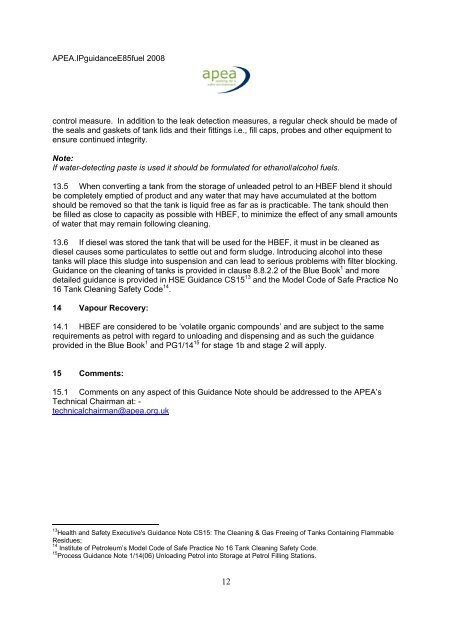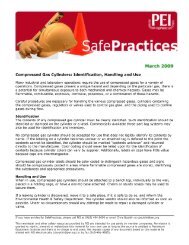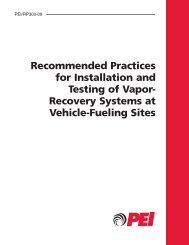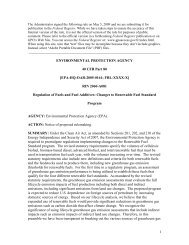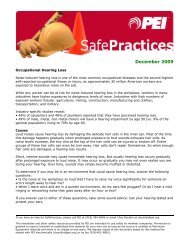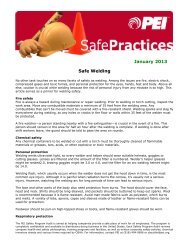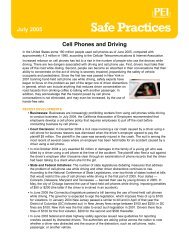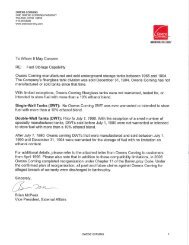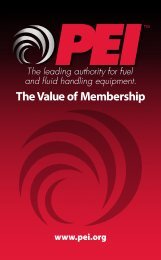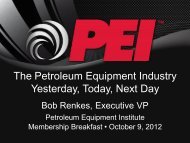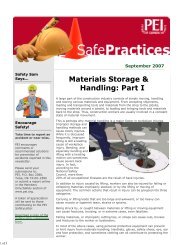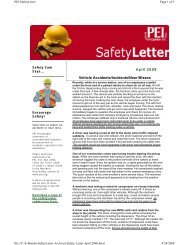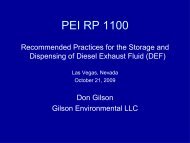1 APEA/IP Guidance on Storage and Dispensing of High Blend ...
1 APEA/IP Guidance on Storage and Dispensing of High Blend ...
1 APEA/IP Guidance on Storage and Dispensing of High Blend ...
You also want an ePaper? Increase the reach of your titles
YUMPU automatically turns print PDFs into web optimized ePapers that Google loves.
<str<strong>on</strong>g>APEA</str<strong>on</strong>g>.<str<strong>on</strong>g>IP</str<strong>on</strong>g>guidanceE85fuel 2008c<strong>on</strong>trol measure. In additi<strong>on</strong> to the leak detecti<strong>on</strong> measures, a regular check should be made <strong>of</strong>the seals <strong>and</strong> gaskets <strong>of</strong> tank lids <strong>and</strong> their fittings i.e., fill caps, probes <strong>and</strong> other equipment toensure c<strong>on</strong>tinued integrity.Note:If water-detecting paste is used it should be formulated for ethanol/alcohol fuels.13.5 When c<strong>on</strong>verting a tank from the storage <strong>of</strong> unleaded petrol to an HBEF blend it shouldbe completely emptied <strong>of</strong> product <strong>and</strong> any water that may have accumulated at the bottomshould be removed so that the tank is liquid free as far as is practicable. The tank should thenbe filled as close to capacity as possible with HBEF, to minimize the effect <strong>of</strong> any small amounts<strong>of</strong> water that may remain following cleaning.13.6 If diesel was stored the tank that will be used for the HBEF, it must in be cleaned asdiesel causes some particulates to settle out <strong>and</strong> form sludge. Introducing alcohol into thesetanks will place this sludge into suspensi<strong>on</strong> <strong>and</strong> can lead to serious problems with filter blocking.<str<strong>on</strong>g>Guidance</str<strong>on</strong>g> <strong>on</strong> the cleaning <strong>of</strong> tanks is provided in clause 8.8.2.2 <strong>of</strong> the Blue Book 1 <strong>and</strong> moredetailed guidance is provided in HSE <str<strong>on</strong>g>Guidance</str<strong>on</strong>g> CS15 13 <strong>and</strong> the Model Code <strong>of</strong> Safe Practice No16 Tank Cleaning Safety Code 14 .14 Vapour Recovery:14.1 HBEF are c<strong>on</strong>sidered to be ‘volatile organic compounds’ <strong>and</strong> are subject to the samerequirements as petrol with regard to unloading <strong>and</strong> dispensing <strong>and</strong> as such the guidanceprovided in the Blue Book 1 <strong>and</strong> PG1/14 15 for stage 1b <strong>and</strong> stage 2 will apply.15 Comments:15.1 Comments <strong>on</strong> any aspect <strong>of</strong> this <str<strong>on</strong>g>Guidance</str<strong>on</strong>g> Note should be addressed to the <str<strong>on</strong>g>APEA</str<strong>on</strong>g>’sTechnical Chairman at: -technicalchairman@apea.org.uk13 Health <strong>and</strong> Safety Executive's <str<strong>on</strong>g>Guidance</str<strong>on</strong>g> Note CS15: The Cleaning & Gas Freeing <strong>of</strong> Tanks C<strong>on</strong>taining FlammableResidues;14 Institute <strong>of</strong> Petroleum’s Model Code <strong>of</strong> Safe Practice No 16 Tank Cleaning Safety Code.15 Process <str<strong>on</strong>g>Guidance</str<strong>on</strong>g> Note 1/14(06) Unloading Petrol into <strong>Storage</strong> at Petrol Filling Stati<strong>on</strong>s.12


